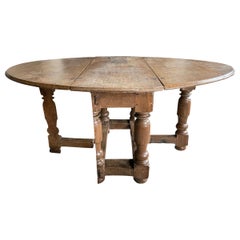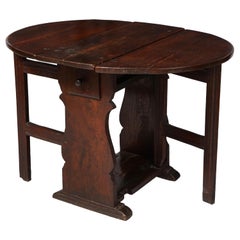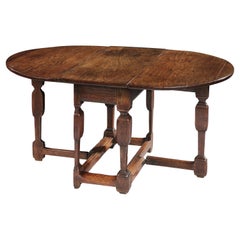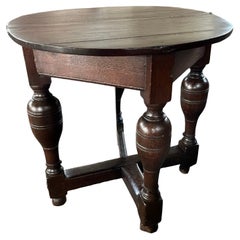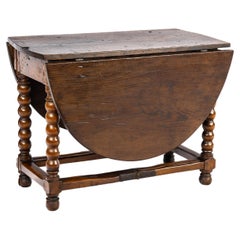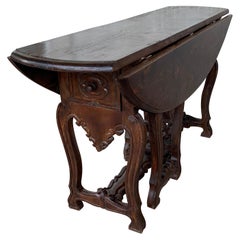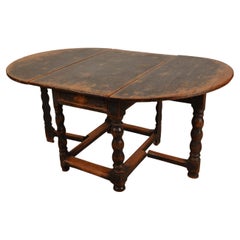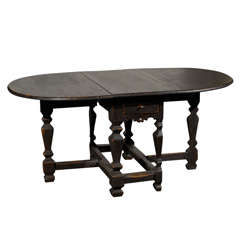Baroque Gateleg Table
Antique 17th Century Danish Baroque Dining Room Tables
Oak
Antique Late 17th Century Welsh Baroque Drop-leaf and Pembroke Tables
Oak
Antique 1650s Dutch Baroque Dining Room Tables
Oak
Antique Early 18th Century Dutch Baroque Drop-leaf and Pembroke Tables
Oak
Antique Late 17th Century Spanish Baroque Drop-leaf and Pembroke Tables
Chestnut
Antique Late 19th Century Spanish Baroque Drop-leaf and Pembroke Tables
Oak
Recent Sales
Antique Mid-18th Century Swedish Baroque Tables
Pine
Antique 18th Century Swedish Baroque Drop-leaf and Pembroke Tables
Oak, Paint
Antique Early 18th Century English Baroque Drop-leaf and Pembroke Tables
Oak
Antique 18th Century and Earlier Spanish Tables
Walnut
Antique 18th Century and Earlier Italian Tables
Walnut
People Also Browsed
21st Century and Contemporary American Bohemian Chandeliers and Pendants
Brass
21st Century and Contemporary Swedish Mid-Century Modern Table Lamps
Textile
2010s Table Lamps
Iron
2010s American Table Lamps
Brass
Antique 19th Century English Victorian Sofas
Brass
Antique 19th Century English Chinese Chippendale Vitrines
Glass, Mahogany
21st Century and Contemporary Italian Classical Greek Stone Sinks
Marble, Limestone
21st Century and Contemporary French Art Deco Side Chairs
Wrought Iron
Antique 18th Century French French Provincial Farm Tables
Fruitwood
Antique 19th Century English Early Victorian Sofas
Leather
Antique Late 18th Century English George III Dining Room Tables
Oak
Antique Late 19th Century British Chesterfield Sofas
Leather
Antique 18th Century Italian Renaissance Revival Dining Room Tables
Oak, Walnut
Antique Early 19th Century English Regency Center Tables
Mahogany
Antique 1780s English George III Armchairs
Leather
Antique 19th Century English Elizabethan Dining Room Tables
Oak
A Close Look at Baroque Furniture
The decadence of the Baroque style, in which ornate furnishings were layered against paneled walls, painted ceilings, stately chandeliers and, above all, gilding, expressed the power of the church and monarchy through design that celebrated excess. And its influence was omnipresent — antique Baroque furniture was created in the first design style that truly had a global impact.
Theatrical and lavish, Baroque was prevalent across Europe from the 17th to mid-18th century and spread around the world through colonialism, including in Asia, Africa and the Americas. While Baroque originated in Italy and achieved some of its most fantastic forms in the late-period Roman Baroque, it was adapted to meet the tastes and materials in each region. French Baroque furniture informed Louis XIV style and added drama to Versailles. In Spain, the Baroque movement influenced the elaborate Churrigueresque style in which architecture was dripping with ornamental details. In South German Baroque, furniture was made with bold geometric patterns.
Compared to Renaissance furniture, which was more subdued in its proportions, Baroque furniture was extravagant in all aspects, from its shape to its materials.
Allegorical and mythical figures were often sculpted in the wood, along with motifs like scrolling floral forms and acanthus leaves that gave the impression of tangles of dense foliage. Novel techniques and materials such as marquetry, gesso and lacquer — which were used with exotic woods and were employed by cabinetmakers such as André-Charles Boulle, Gerrit Jensen and James Moore — reflected the growth of international trade. Baroque furniture characteristics include a range of decorative elements — a single furnishing could feature everything from carved gilded wood to gilt bronze, lending chairs, mirrors, console tables and other pieces a sense of motion.
Find a collection of authentic antique Baroque tables, lighting, decorative objects and other furniture on 1stDibs.
Finding the Right Tables for You
The right vintage, new or antique tables can help make any space in your home stand out.
Over the years, the variety of tables available to us, as well as our specific needs for said tables, has broadened. Today, with all manner of these must-have furnishings differing in shape, material and style, any dining room table can shine just as brightly as the guests who gather around it.
Remember, when shopping for a dining table, it must fit your dining area, and you need to account for space around the table too — think outside the box, as an oval dining table may work for tighter spaces. Alternatively, if you’ve got the room, a Regency-style dining table can elevate any formal occasion at mealtime.
Innovative furniture makers and designers have also redefined what a table can be. Whether it’s an unconventional Ping-Pong table, a brass side table to display your treasured collectibles or a Louis Vuitton steamer trunk to add an air of nostalgia to your loft, your table can say a lot about you.
The visionary work of French designer Xavier Lavergne, for example, includes tables that draw on the forms of celestial bodies as often as they do aquatic creatures or fossils. Elsewhere, Italian architect Gae Aulenti, who looked to Roman architecture in crafting her stately Jumbo coffee table, created clever glass-topped mobile coffee tables that move on bicycle tires or sculpted wood wheels for Fontana Arte.
Coffee and cocktail tables can serve as a room’s centerpiece with attention-grabbing details and colors. Glass varieties will keep your hardwood flooring and dazzling area rugs on display, while a marble or stone coffee table in a modern interior can showcase your prized art books and decorative objects. A unique vintage desk or writing table can bring sophistication and even a bit of spice to your work life.
No matter your desired form or function, a quality table for your living space is a sound investment. On 1stDibs, browse a collection of vintage, new and antique bedside tables, mid-century end tables and more .
- What is a gateleg table?1 Answer1stDibs ExpertApril 29, 2020
First introduced in 16th century-England, a gateleg table is a popular kind of table that allowed for intimate dining. The tabletop of the gateleg table, which was initially round or oval versus the long tables and formal seating arrangements that preceded it, had a section that was fixed in place, while one or two sections of the surface were equipped with hinges. By design, a gateleg table could be extended so that more space could be allocated for work or for dining if needed. These hinged sections could be folded back into place on top of the fixed section or could easily be dropped down to hang vertically on their hinges when they weren’t in use. This function, which allowed the table’s drop leaves that weren’t in use to be pushed up against a wall, saved space in small homes because the table could be tucked away. Pivoted legs under the table — which formed a gate as they were joined at their tops and bottoms by crosspieces — supported the hinged sections.
- What does a gateleg table mean?1 Answer1stDibs ExpertMarch 16, 2020
“Gate” in “gateleg table” refers to the pivoted leg supports under the table that are connected at their ends by crosspieces. When raised, the table’s two drop leaves, which are usually D-shaped, are supported upon these gates. When gateleg tables originated in England in the 16th century, they were oval or round and were generally named after their shape (and weren’t yet called gateleg tables) in order to distinguish them from the long tables they’d replaced, as dining had by then been relegated to meals for the family, not an entire household and assembled guests.
- 1stDibs ExpertFebruary 17, 2023The difference between a gateleg table and a drop leaf table is the design of the section that you can raise to expand the piece. On a drop leaf table, the extension does not have any lower support. A gateleg table has a leg that swings out to rest beneath the extension. Find a selection of tables from some of the world's best sellers on 1stDibs.
